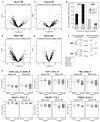Breast tumor DNA methylation patterns associated with smoking in the Carolina Breast Cancer Study
- PMID: 28275920
- PMCID: PMC5592727
- DOI: 10.1007/s10549-017-4178-8
Breast tumor DNA methylation patterns associated with smoking in the Carolina Breast Cancer Study
Abstract
Purpose: Tobacco smoking is a risk factor in several cancers, yet its roles as a putative etiologic exposure or poor prognostic factor in breast cancer are less clear. Altered DNA methylation contributes to breast cancer development and may provide a mechanistic link between smoking and gene expression changes leading to cancer development or progression.
Methods: Using a cancer-focused array, we examined methylation at 933 CpGs in 517 invasive breast tumors in the Carolina Breast Cancer Study to determine whether methylation patterns differ by exposure to tobacco smoke. Multivariable generalized linear regression models were used to compare tumor methylation profiles between smokers and never smokers, overall, or stratified on hormone receptor (HR) status.
Results: Modest differences in CpG methylation were detected at p < 0.05 in breast tumors from current or ever smokers compared with never smokers. In stratified analyses, HR- tumors from smokers exhibited primarily hypomethylation compared with tumors from never smokers; hypomethylation was similarly detected within the more homogeneous basal-like subtype. Most current smoking-associated CpG loci exhibited methylation levels in former smokers that were intermediate between those in current and never smokers and exhibited progressive changes in methylation with increasing duration of smoking. Among former smokers, restoration of methylation toward baseline (never smoking) levels was observed with increasing time since quitting. Moreover, smoking-related hypermethylation was stronger in HR+ breast tumors from blacks than in whites.
Conclusions: Our results suggest that breast tumor methylation patterns differ with tobacco smoke exposure; however, additional studies are needed to confirm these findings.
Keywords: Breast cancer; Breast tumor; Epigenetic; Methylation; Smoking.
Figures



References
-
- Ernster VL. Female lung cancer. Ann Rev Public Health. 1996;17:97–114. - PubMed
-
- Boffetta P, Mashberg A, Winkelman R, Garfinkel L. Carcinogenic effect of tobacco smoking and alcohol drinking on anatomic sites of the oral cavity and oropharynx. Int J Cancer. 1992;52:530–533. - PubMed
-
- Castelao JE, Yuan J-M, Skipper PL, Tannenbaum SR, Gago-Dominguez M, Crowder JS, Ross RK, Yu MC. Gender-and smoking-related bladder cancer risk. J Natl Cancer Inst. 2001;93:538–545. - PubMed
-
- Reynolds P. Smoking and breast cancer. J Mammary Gland Biol Neoplasia. 2013;18:15–23. - PubMed
-
- Macacu A, Autier P, Boniol M, Boyle P. Active and passive smoking and risk of breast cancer: a meta-analysis. Breast Cancer Res Treat. 2015;154:213–224. - PubMed
MeSH terms
Substances
Grants and funding
LinkOut - more resources
Full Text Sources
Other Literature Sources
Medical

